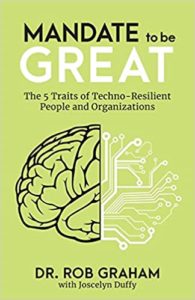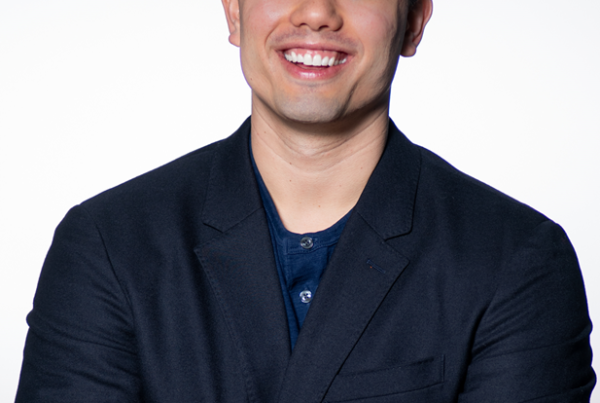Podcast: Play in new window | Download
Subscribe: RSS
How do we bring out the best in people while doing more with less?

Dr. Rob Graham
Twenty-five years ago, Dr. Rob Graham Ph.D. was a special education teacher in a grade school when he was asked to be the school’s first IT teacher. Personal computers were just emerging, colleagues feared digital interfaces, and available technologies were not cost-effective. He built the first PC-based networked computer lab in the district and a thriving community around it. Techno-resiliency was born.
He has since gone on to teach over 10,000 students; create an award-winning, research-based theoretical lens; and complete a Ph.D. in e-Research & Technology Enhanced Learning from Lancaster University in the U.K.
Today, technoresiliency.com empowers business and educational leaders and their teams to thrive in technology-enriched workplaces.
He has written two books: Techno-Resiliency in Education – A New Approach for Understanding Technology in Education, and Mandate to Be Great: 5 Traits of TechnoResilient People and Organizations, which was released this month and quickly became an Amazon bestseller.
What We Discuss With Dr. Rob Graham
- How to create technoresilient organizations
- The 5 traits of techno-resiliency and the Mandate To Be Great
- How to inspire willingness within your organization
- The difference between barriers and lack ofs
- How to do more with less
- The power of spontaneous collaboration
Transcript Highlights
Introduce us to this concept of Techno-resiliency and how you discovered it.
When I was a university professor teaching technology enhanced teaching and learning I used to tell my students, “Beware of techno-lust,” which is technology for the sake of technology.
One of the important messages in Mandate To Be Great is not necessarily people before profits, but put your people first and you will profit. So even though the message sounds really techy, the whole book and what I do is really about putting people first.
All organizations have pockets of resilience. The first way to expand them is to recognize them.
As for how I define it, techno-resiliency means cultivating your capacity for thriving in a technology-enhanced workplace by maximizing efficiencies, resources and team efficiencies, while minimizing costs and complexities.
Many years ago when I was a masters’ student, I was exposed to a piece of research by (Norman) Garmezy on child development. He asked, “What if we could look at kids in really challenged and impoverished living conditions and identify kids that were resilient – they were overcoming as opposed to be overcome by their environments? And could we somehow extrapolate their coping mechanisms and what they’re doing to thrive in environments where other kids aren’t?” His model was called research vulnerability. So he was looking at the two sides – resilience and vulnerability.
Many years later, when I began working in technology and became a doctoral student in England, that research that I was confronted with all those years ago made me think, “What if we could look at organizations that were making use of technology but with limited funds, limited expertise, and limited training, and identify what these professionals were doing? We could train other organizations how to overcome, as opposed to being overcome by what I call ‘lack-ofs’.”
Long story short, the whole notion of techno-resiliency, the theoretical framework and what I’ve built the Mandate To Be Great on, is the research I conducted in organizations that said, how can you do more with less? Really that’s the question it becomes.
In the wake of this pandemic, how have you been implementing techno-resiliency within organizations?
I’m so excited for the book to come out, Mandate to Be Great: The 5 Traits of TechnoResilient People and Organizations. It lays out the actual blueprint for organizational excellence. As I researched these organizations – the organizations that were overcoming – it was so remarkable to me that the people in these organizations had a desire to do better, to be better and to make others better. They were also willing to be inspired. It’s really important that it’s a two-way street.
What I noticed is that the leadership team in these organizations had cultivated a psychological responsive and emotionally responsive workplace where the people desired to do better, be better and make others better – they desired to inspire but were also willing to be inspired.
What the Mandate To Be Great outlines through my research lens, is how these organizations were able to create this kind of work environment.
How do you inspire willingness in people?
I address it in the book, but in my research I identified that all organizations have pockets of resilience – people that want to do better, be better and are making others better. As leaders, we have to find those people, acknowledge them, and allow opportunities for them to be contagions for organizational excellence. If we let them stay as pockets…the organization will become stagnant.
Leaders need to understand that you are judged daily, not by your HR policies and policies, but by your actions, inactions, and reactions. Now with COVID, we have to, through our HR policies and our lived actions, create emotionally and psychologically responsive work environments.
One of the things I noticed in the organizations I worked with is that they didn’t have a lot of finances and one of the ways they were able to overcome that is that they had a lot of in-house PD. They avoided a lot of external and very expensive professional development but they really made use of the resources and people in their organization.
To recap, organizations need to be aware of these pockets of resiliency, and then they need to acknowledge them, and look for ways to place those people around others.
What are the 5 traits of techno-resiliency that you talk about in your book?
The first is that actual Mandate To Be Great. That is at the heart of the book. I talked about the organizations I worked with – they created psychologically and emotionally responsive workplaces. The people working there were partly products of this environment that believed in them. So it was reciprocal. When I interviewed the employees, they had tremendous respect for their leaders and when I interviewed the leaders, they had a tremendous amount of respect and belief in their employees.
The second trait is Know What, Know How and Know Where. You don’t have to know it all in the 21st century. With people working from home today, it’s more important to know where to find information in a timely manner. So teaching people how to use the information that is at their disposal is more important than getting them to memorize manuals, etc. So know what, and know where is more important that know how.
The third trait is Barriers To Bridges. This was pivotal to me getting my doctoral thesis. When I went into these organizations, they didn’t see them as barriers. Barriers assume that people don’t want to scale things. It assumes they don’t have the capacity to do it. There is organizational inequity when it comes to technology. I call them lack ofs. Organizations don’t have barriers but they might have lack ofs.
If an organization sees them as lack ofs verses barriers, they can ask, “What can our organization do to set on course how we can overcome as opposed to being overcome by the lack ofs?”
What do we do? We set goals, prioritize, and in my case, I conduct a techno-resiliency audit with the people. We find out what are the lack ofs. Once we identify the lack ofs, what do we do to overcome them as opposed to being overcome by them?
Four is The Drive To Thrive. It’s all about the unification of the organization. It’s the power of the collective. That’s where I talk about self-determination verses self-motivation. A lot of time collaboration is an impostor for cooperation. A lot of organizations think they’re collaborating when in fact they’re cooperating, and/or coordinating. At all times organizations might need collaboration, cooperation and coordination, but I think a lot of organizations are fooling themselves into thinking that they are collaborating.
Collaboration and cooperation are very close. I like to tell people that collaboration is cooperation on steroids. What we know about collaboration is that there needs to be extremely high levels of trust built, there’s intellectual agility, diverse skill sets, open communication, a sense of shared vision, and belongingness. That’s really hard to achieve. It’s really messy to do.
The Kingdom Of Freedom is really cool (Trait #5). How does an organization do more with less? The organizations I researched and worked with weren’t afraid of older technologies, they believed in one other, they made use of in-house professional development, and they were willing to go above and beyond and find solutions to problems outside of hiring people to find them. Organizations today need to really capitalize on their internal capacities.
We’re in a time where organizations need more from their employees. Most of our employee base is working from home now. Are we able to get more from our employees, working from home now? I think we can.
I talk about spontaneous collaboration. We’ve all heard about Google and some of these major tech corporations where they’ve spent millions creating environments where people don’t want to leave and they don’t have to leave. They created spaces where people could sit and spontaneously collaborate. But now in COVID, even Zuckerberg was worried about how to enact these – I call it spontaneous collaboration – can we do it with people working from home?
Kingdom of Freedom – Trait 5 – is how organizations have been able to make use of the resources around them and leverage cost effective efficiencies.
The combination of these five traits I really believe offer some of the deeper insights, but also inspiration, because inspiration is innovation today. Where does our inspiration largely come from? It comes from you and me and being together in that collective.
Episode Resources 
Mandate to Be Great: 5 Traits of TechnoResilient People and Organizations
Connect With Dr. Rob Graham
http://www.technoresiliency.com
Did You Enjoy The Podcast?
If you enjoyed this episode please let us know! 5-star reviews for the Leaders Of Transformation podcast on Apple Podcasts, Spotify, Pandora or Stitcher are greatly appreciated. This helps us reach more purpose-driven entrepreneurs seeking to make a positive impact in the world. Thank you. Together, we make a difference!
Additional Episodes You May Like
- 172: Joscelyn Duffy: Finding Your Unique Voice
- 359: Dave Willner: Maintaining an Employee First Culture in Difficult Times
- 345: Melissa Lamson: Managing Well in a Complex Business Environment
- 323: Christine Comaford: How To Increase Your Emotional Resilience In Uncertain Times
- 321: Dr. Jeffrey Spahn: The Evolution of Leadership in the Midst Of Crisis










